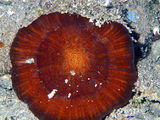Scleractinians: Difference between revisions
| Line 69: | Line 69: | ||
====[https://picasaweb.google.com/ENST259/CoralsFleshy Fleshy]==== | ====[https://picasaweb.google.com/ENST259/CoralsFleshy Fleshy]==== | ||
*ex. Artichoke Coral | *ex. Artichoke Coral [[File:artichoke.jpeg|frameless|left|160px]] | ||
====[https://picasaweb.google.com/ENST259/CoralsFloweringAndCup Flowering and Cup]==== | ====[https://picasaweb.google.com/ENST259/CoralsFloweringAndCup Flowering and Cup]==== | ||
Revision as of 19:42, 15 April 2014
Scleractinian/Stony Corals
Stony Corals are also known as Hard Corals. They are considered the reef builders of the ecosystem because of the calcium carbonate skeleton they secrete, which distinguishes them from soft corals. We will discuss the classification, evolutionary history, skeleton and colony formation, behavior and environment of stony corals, and then discuss some particular examples common to St. John and the US Virgin Islands.
Classification
Kingdom:Animalia
Stony Corals belong to the animal kingdom, which include eukaryotic multicellular organisms that i) form from blastula embryos ii) are loosely mobile and iii) gain nutrients through ingesting food.[1]
Phylum: Cnidaria
Members of the phylum Cnidaria share common characteristics including i) a body open to the external environment ii) radial or biradial symmetry iii) a diploblast structure and iv) nematocysts. Intrinsic nematocysts are capsules of specialized cells that will uncoil and extend rapidly when stimulated, usually to either sting as a form of defense or to capture food. Other organisms other than stony corals that are classified as Cnidaria include jellyfish, sea anenomes, portuguese man of war, hydroids and freshwater hydra. [2] This means that, despite popular belief, stony corals are more closely related to jellyfish than sponges.
Class: Anthozoa
The class anthozoa is classified by i) having no medusoid phase in the life cycle and ii) liveing in the form of polyps because their skeletons function for protection and not movement. and iii) existing solely in marine environments. [3]
Subclass: Hexacorallia
The subclass hexacorallia to which sea anenomes, black corals and stony corals belong is characterized by tubular polyps that have tentacles in multiples of six. [4]
Order: Scleractinia
Scleractinia comprise of stony corals. This order is distinct because of their hard skeleton attached to a firm substrate. [5]
Evolutionary History
Because of their hard calcium carbonate skeleton, stony corals have a rich fossil record. They first appeared in the mid-triassic period, after replacing their softer bodied relatives, skeletonized rugose and tabulate corals, which went extinct in the Permian Extinction. The Late Jurassic Period showed the most biodiversity of corals with more than 200 genera. While hard coral began to get outcompeted by rudist bivalves the Early Cretaceous, this effect was minimized by the Late Cretaceous due to the extinction of the rudist bivalves, during which coral existed worldwide. From the ecocene to today, hard coral remains dominant in reefs, but mainly in tropical areas. [6][5]
Skeleton and Colony Formation
A coral may be either a solitary polyp (an individual coral animal) or a colony of thousands of polyps that are connected by a continuous horizontal tissue called the coensarc. The coensarc is an extension of the polyps body walls that creates a common gastrovascular system that allows the polyps to share food, water and wastes; so successful feeding by individual polyps benefits the colony as a whole. Polyps generally range in diameter from 1-3 mm for colonial corals and can get up to 25 cm in some solitary corals.[7]
The entire coral skeleton is called the corallum and it is made up of individual coral units called corallites. The calcium carbonate (CaCO3) skeleton is secreted by ectodermal calcioblasts in the lower portion of the polyp.
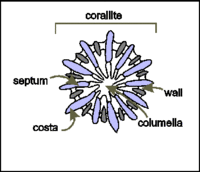
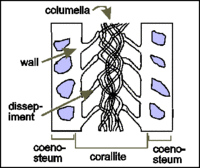
After landing on the substrate, the polyp begins by secreting a thin skeletal basal plate, from which septa (vertical plate-like partitions) radiate outwards; this is followed by formation of the theca (the skeletal wall). The inner-septa often fuse to form a columella (central axis of the corallite found beneath the polyp mouth). The polyp now sits in a cup-like depression called the calyx (defined by the theca and the basal plate). Additional structures include the coenosteum (the skeletal structure beneath the coensarc) and the calice (the outermost surface of the corallite). From the above description you can see that most of the polyp is impregnated with a calcareous (composed of calcite, or calcium carbonate) skeleton.[5]
Periodically a polyp may lift off its base to secrete a new basal plate above the old one, leading to the creation of a new chamber within the skeleton. Living coral deposits CaCO3 in this manner, adding partitions and elevating the corallum.[8] The coral can also grow horizontally by the budding of new polyps by asexual reproduction.Oral discs around the polyps mouth produce the new polyps and the process additionally lengthens the oral disc and leads to the formation of new mouths in it. For example, a common oral disk containing many mouths is shared by a row of brain coral polyps.[9]
Behavior
Reproduction
Stony Corals can reproduce sexually and asexually. Sexual reproduction allows for spread of coral to new places and forms a genetically unique coral. It occurs when large numbers of male and female gametes are released into the ocean, which join to form floating larvae called planulae. After floating in the light, surface level of the ocean for 2 days to (in rare cases) 2 months, a small percentage of these planulae settle and grow into corals, which explains why it is necessary to have such extensive amounts of gametes released. Asexual reproduction allows for the growth of corals by creating a coral with the same genetic makeup as the parent cell. This occurs through budding and splitting. [10]
Feeding
Like all animals, corals must ingest food in order to obtain their nutrients. Due to their hard, protective skeleton and their attachment to a firm substrate, corals cannot move to obtain their food like most animals do. One way corals obtain nutrients is by using their tentacles to capture phytoplankton, zooplankton, dissolved organic matter, dissolved inorganic matter, particulate organic matter and bacteria floating through the water. The second way in which corals obtain nutrients is through their symbiotic relationship with zooxanthellae, in which zooxanthellae obtain a habitat from coral, while performing photosynthesis to provide some energy for the coral. [11]
Nematocyst Behavior
A nematocyst is a capsule of specialized cells that will extend out of their coiled formation in order to sting a threat or capture food. While only cnidaria produce nematocysts, other animals may have an ability to store these safely in their body and release it as a defense mechanism. Each nematocyst can only be used once and takes extensive energy to make, so it is beneficial to not overuse the nematocysts. It has been shown that cnidarians are capable of controlling the release of a nematocyst, based on a stimulation. While there are over 30 morphologically distinct nematocysts, there are three main functional categories of nematocysts. A volvent wraps around its prey to capture it, despite being unarmed. A penetrant captures its prey by using barbs to deliver a toxin. A glutinant is used to obtain food through using a sticky substance to attach the prey to its tentacle. [2]
Environment
- Stony Corals do well in tropical and subtropical areas which have warm and clear water
- Stony Corals have also been found in deep, dark water that is up to 6,500 feet deep
Classification of Corals by Shape
The shape of the colony varies and depends on: character and size of polyp, growth rate, and mode of reproduction. Stony coral shapes generally fall under one of the following categories: brain, branching, massive (also to as mound – these corals are similar in all directions), encrusting (corals adhere to a substrate), columnar (forms columns or pillars), foliaceous (leaf-like), laminar (plate-like), and free-living (fleshy).[12]
Examples with Class Photos from the US/British Virgin Islands in the Caribbean
Click on the links to access pictures taken during our ENST 259 trip to St. John to see examples of the following broad categories of stony corals!
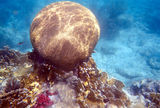

Brain
- ex. Grooved Brain Coral (Diploria labyrinthiformis) This is a characteristic example of the family favidae, which tends to be massive, slow growing colonies. Its defining feature is broad ridges separated by deep valleys. The grooved brain coral ranges in color from tan to brown to gray. Its tentacle tips are often visible. [13]
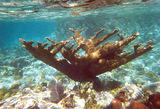
Branching
- ex. Elkhorn Coral (Acropora palmata) As a member of the family acroporidae, Elkhorn coral shows characteristic fast growing qualities and branching shape. [13]
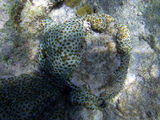
Encrusting, Mound, and Boulder
- ex. Blushing Star Coral [13]
Fleshy
Flowering and Cup
- ex. Orange Cup Coral
Leaf, Plate, and Sheet
- ex. Fragile Saucer Coral
Notes
- ↑ Schwartz, Dr. Karlene V. "Animal Kingdom." AccessScience. McGraw-Hill Education, 2014. Web. 14 April 2014. http://www.accessscience.com/content/animal-kingdom/035700
- ↑ 2.0 2.1 Fautin, Dr. Daphne G. and Stevens, Dr. Calvin H. "Cnidaria" AccessScience. McGraw-Hill Education, 2014. Web. 28 Feb. 2014. http://www.accessscience.com/content/cnidaria/145900
- ↑ Fautin, Dr. Daphne G. and Oliver, Dr. William A. "Anthozoa" AccessScience. McGraw-Hill Education, 2014. Web. 3 March 2014. http://www.accessscience.com/content/anthozoa/038800
- ↑ Fautin, Dr. Daphne G. "Hexacorallia" AccessScience. McGraw-Hill Education, 2014. Web. 3 March 2014. http://www.accessscience.com/content/hexacorallia/755800
- ↑ 5.0 5.1 5.2 Atoda, Dr. Kenji and Pandolfi, Dr. John M. “Scleractinia.” AccessScience. McGraw-Hill Education, 2014. Web. 26 Feb. 2014. http://www.accessscience.com/content/scleractinia/607500
- ↑ MarineBio Conservation Society. (n.d.). Coral Reefs. Web. http://marinebio.org/oceans/coral-reefs.asp
- ↑ Ginsburg, R. N. (2007). Atlantic and Gulf Rapid Reef Assessment: Anatomy of Corals . Web.http://www.agrra.org/background/coralback1.html
- ↑ National Ocean Service. (March 25,2008). Corals: How Do Corals Grow? What Forms Do They Take?. Web. http://oceanservice.noaa.gov/education/kits/corals/coral03_growth.html
- ↑ Hughes, A. (2002, June). If I only Had a Brain: An Introduction to Stony Coral. OK Scuba, 40–41. Web. http://www.okscuba.com/braincoral.pdf
- ↑ National Ocean Service. (July 21,2009). How do Corals Reproduce? http://oceanservice.noaa.gov/education/kits/corals/coral06_reproduction.html
- ↑ Goreau, Thomas F, Goreau, Nora I. and Yonge, C. M. (Oct. 1971) Reef Corals: Autotrophs or Heterotrophs. Discovery Bay Marine Labaratory. University of the West Indies, Kingston 7, Jamaica and University of Edinburgh, Edinburgh, Scotland
- ↑ Van Woesik, R. (n.d.). Scleractinian Taxonomy, 4–8.
- ↑ 13.0 13.1 13.2 Humann, Paul, and Ned Deloach. Reef Coral Identification: Florida, Caribbean, Bahamas. 2nd ed. Jacksonville, FL: New World Publications, 2002. Print.
- MarineBio Conservation Society. (n.d.). Coral Reefs. Web. http://marinebio.org/oceans/coral-reefs.asp
- Stanley, G. D. (1996). Paleobiology and biology of corals. Columbus, OH: Paleontological Society.
- Dubinsky, Z., & Stambler, N. (Eds.). (2011). Coral Reefs: An Ecosystem in Transition. London: Springer.
- National Ocean Service. (March 25,2008). Corals: How Do Corals Grow? What Forms Do They Take?. Web. http://oceanservice.noaa.gov/education/kits/corals/coral03_growth.html
- Sheppard, C. R., Davy, S. K., & Pilling, G. M. (2009). The Main Reef Builders and Space Occupiers. The Biology of Coral Reefs. New York: Oxford University Press Inc. doi:10.1093/acprof:oso/9780198566359.001.0001
